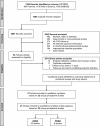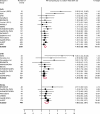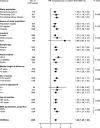Asymmetric dimethylarginine and cardiovascular risk: systematic review and meta-analysis of 22 prospective studies
- PMID: 26021436
- PMCID: PMC4599532
- DOI: 10.1161/JAHA.115.001833
Asymmetric dimethylarginine and cardiovascular risk: systematic review and meta-analysis of 22 prospective studies
Abstract
Background: Asymmetric dimethylarginine (ADMA) inhibits the production of nitric oxide, a key regulator of the vascular tone, and may be important in the development of cardiovascular disease (CVD). Our aim was to reliably quantify the association of ADMA and its isomer symmetric dimethylarginine (SDMA) with the risk of CVD outcomes in long-term cohort studies.
Methods and results: Data were collated from 22 prospective studies involving a total of 19 842 participants, which have recorded 2339 CVD, 997 coronary heart disease, and 467 stroke outcomes during a mean follow-up of 7.1 years. In a comparison of individuals in the top with those in the bottom third of baseline ADMA values, the combined risk ratios were 1.42 (95% confidence interval: 1.29 to 1.56) for CVD, 1.39 for coronary heart disease (1.19 to 1.62), and 1.60 for stroke (1.33 to 1.91). Broadly similar results were observed according to participants' baseline disease status (risk ratios for CVD: 1.35 [1.18 to 1.54] in general populations; 1.47 [1.16 to 1.87] in individuals with pre-existing CVD; and 1.52 [1.26 to 1.84] in individuals with pre-existing kidney disease) and by different study characteristics, including geographical location, sample type, assay method, number of incident outcomes, and level of statistical adjustment (all P values>0.05). In contrast, in 8 prospective studies involving 9070 participants and 848 outcomes, the corresponding estimate for SDMA concentration was 1.32 (0.92 to 1.90) for CVD.
Conclusions: Available prospective studies suggest associations between circulating ADMA concentration and CVD outcomes under a broad range of circumstances. Further research is needed to better clarify these associations, particularly in large general population studies.
Keywords: asymmetric dimethylarginine; cardiovascular diseases; meta‐analysis; prospective studies.
© 2015 The Authors. Published on behalf of the American Heart Association, Inc., by Wiley Blackwell.
Figures






References
-
- Palmer RM, Ferrige AG, Moncada S. Nitric oxide release accounts for the biological activity of endothelium-derived relaxing factor. Nature. 1987;327:524–526. - PubMed
-
- Furchgott RF, Zawadzki JV. The obligatory role of endothelial cells in the relaxation of arterial smooth muscle by acetylcholine. Nature. 1980;288:373–376. - PubMed
-
- Vallance P, Leone A, Calver A, Collier J, Moncada S. Accumulation of an endogenous inhibitor of nitric oxide synthesis in chronic renal failure. Lancet. 1992;339:572–575. - PubMed
-
- Bai Y, Sun L, Du L, Zhang T, Xin W, Lan X, Du G. Association of circulating levels of asymmetric dimethylarginine (ADMA) with carotid intima-media thickness: evidence from 6168 participants. Ageing Res Rev. 2013;12:699–707. - PubMed
-
- Böger GI, Rudolph TK, Maas R, Schwedhelm E, Dumbadze E, Bierend A, Benndorf RA, Böger RH. Asymmetric dimethylarginine determines the improvement of endothelium-dependent vasodilation by simvastatin: effect of combination with oral l-arginine. J Am Coll Cardiol. 2007;49:2274–2282. - PubMed
Publication types
MeSH terms
Substances
Grants and funding
LinkOut - more resources
Full Text Sources

